Calligraphy in Takamatsu
2014年09月25日
Franz Kline (1910~1962) the American mainly abstract Expressionist painter once said something I’ve always remembered; “The final test of a painting, theirs, mine, any other, is; does the painter’s emotions come across?”
http://www.pinterest.com/pin/200832464606218507/
Kline was heavily influenced by the power & emotion of Oriental calligraphy, particularly Japanese calligraphy. Unlike Kline’s oil paintings, in this art form there’s no room for second takes. It happens spontaneously and successfully or not at all.


In the Takamatsu City Gallery for this coming week, there is an exhibition of calligraphy that meets all of Kline’s criteria and then some more.
http://www.city.takamatsu.kagawa.jp/english/sightseeing/sees/takamatsu-city-museum-of-art.html


Almost always based on ‘kanji’ (Chinese characters) the paintings all have a power that cannot fail to be unrecognized and frankly it doesn’t really matter if one can read the kanji or not.


In fact some of the works are beyond the representation of kanji and move into the area of abstract expressionism.

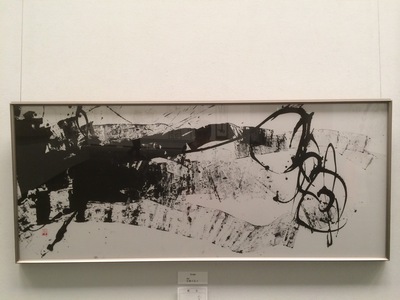
This is an exciting exhibition and well worth a visit. Admission is free and it’s on the second floor of the gallery. Please do drop in to take a look.




** Upcoming events. “Takamatsu=Arts for the upcoming Media Art Festival” next year. Details available as they come to hand so please stay posted on Pat and Cathy’s blog her on the Ashita Sanuki’s Art Takamatsu site.
October 10th~ 19th The Takamatsu Autumn Festival A fireworks display and the 19th Daimyo’s (feudal lord’s) procession in Bushozan just outside Takamatsu and easily accessible by Kotoden train. This is a wonderful event in the historical Bushozan town. Highly recommended!
29th (Wed.) November~3rd November (Mon.) Takamatsu Bonsai Festival.
Details to be announced on this site or call (087) 837 6003.
29th Oct.~1st November (Sat.) Bonsai Stones exhibition at Hiunkaku Tamamo Park
29th Oct. ~1st November Garden light up in Tamamo Park
31st Oct~2nd Nov. Bonsai and garden plants exhibition in Ritsurin Garden (Kikugetsu-tei building)
#1st October~2nd Nov. The Great Bonsai Exhibition and sale in the Kokubunji Bonsai Center
For further information in English or Chinese, please call the Takamatsu City Information office at I-Pal Kagawa
(087) 837 6003
For more info on Takamatsu:
http://wikitravel.org/en/Takamatsu
http://www.city.takamatsu.kagawa.jp/english/
http://tia-takamatsu.jp/
http://www.my-kagawa.jp/eg/
http://www.my-kagawa.jp/special/visitor/kanko/index.htm
http://www.i-pal.or.jp/profile/topics/kagawas-welcome-card.html
Other bloggers in Takamatsu of interest:
http://cathy.ashita-sanuki.jp
http://ogijima.com
http://ww8.tiki.ne.jp/~tmath/home/
http://www.pinterest.com/pin/200832464606218507/
Kline was heavily influenced by the power & emotion of Oriental calligraphy, particularly Japanese calligraphy. Unlike Kline’s oil paintings, in this art form there’s no room for second takes. It happens spontaneously and successfully or not at all.


In the Takamatsu City Gallery for this coming week, there is an exhibition of calligraphy that meets all of Kline’s criteria and then some more.
http://www.city.takamatsu.kagawa.jp/english/sightseeing/sees/takamatsu-city-museum-of-art.html


Almost always based on ‘kanji’ (Chinese characters) the paintings all have a power that cannot fail to be unrecognized and frankly it doesn’t really matter if one can read the kanji or not.


In fact some of the works are beyond the representation of kanji and move into the area of abstract expressionism.


This is an exciting exhibition and well worth a visit. Admission is free and it’s on the second floor of the gallery. Please do drop in to take a look.




** Upcoming events. “Takamatsu=Arts for the upcoming Media Art Festival” next year. Details available as they come to hand so please stay posted on Pat and Cathy’s blog her on the Ashita Sanuki’s Art Takamatsu site.
October 10th~ 19th The Takamatsu Autumn Festival A fireworks display and the 19th Daimyo’s (feudal lord’s) procession in Bushozan just outside Takamatsu and easily accessible by Kotoden train. This is a wonderful event in the historical Bushozan town. Highly recommended!
29th (Wed.) November~3rd November (Mon.) Takamatsu Bonsai Festival.
Details to be announced on this site or call (087) 837 6003.
29th Oct.~1st November (Sat.) Bonsai Stones exhibition at Hiunkaku Tamamo Park
29th Oct. ~1st November Garden light up in Tamamo Park
31st Oct~2nd Nov. Bonsai and garden plants exhibition in Ritsurin Garden (Kikugetsu-tei building)
#1st October~2nd Nov. The Great Bonsai Exhibition and sale in the Kokubunji Bonsai Center
For further information in English or Chinese, please call the Takamatsu City Information office at I-Pal Kagawa
(087) 837 6003
For more info on Takamatsu:
http://wikitravel.org/en/Takamatsu
http://www.city.takamatsu.kagawa.jp/english/
http://tia-takamatsu.jp/
http://www.my-kagawa.jp/eg/
http://www.my-kagawa.jp/special/visitor/kanko/index.htm
http://www.i-pal.or.jp/profile/topics/kagawas-welcome-card.html
Other bloggers in Takamatsu of interest:
http://cathy.ashita-sanuki.jp
http://ogijima.com
http://ww8.tiki.ne.jp/~tmath/home/
Holographic Images Display
2014年07月20日

Takamatsu’s waterfront area is world class. One of the best, and to commemorate the Inland Sea’s becoming the first national park 80 years ago, there will be some special events starting July 19th and running through until August 8th

There will be a hologram projected somehow on to a screen of water mist pumped in to the air with the theme of “Genpei Gasen” or the Genpei Wars, an historical battle between the Taira and Minamoto clans during the late-Heian period of Japan. A time of political turbulence and fierce clan rivalry for the Japanese throne.
I went to the Sunport area and watched the crew working on an anchored on a barge off the shoreline and testing this display. It looked pretty good but the photos I took didn’t, so I took these from the official promotion’s materials.
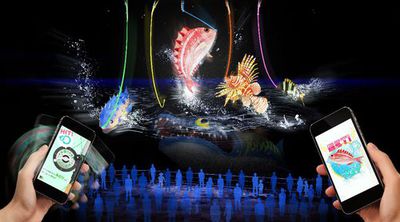
People watching will be able to interact with the hologram using smartphones with the link for the event. Fishing for fish created by the hologram, or catching hologram generated monsters created by the events creaters; TeamLab.
http://www.team-lab.net/en
As you can see from TeamLab’s English site, they’re a very creative group so this should be a wonderful event!
Along with the hologram displays, there will be a wide variety of other performances, street artists, jugglers, food stalls, music by a Self Defense Force big band in the white tent structure in Sunport etc.
Times: The events will start from 17:00 to 21:00, 3 times every night. The hologram display will be held 3 times per evening at the following times.
1st 19:40
2nd 20:30
3rd 21:20
This event will be popular and although free, due to limited numbers, you’ll need a ticket. You can get an advanced ticket (recommended) using Ticketpia at any Lawsons or 7/11 convenience store.
Alternatively, on the day starting at 5:00 at the ticket booth near the Mikayla restaurant on the foreshore and this is very easy to find. Mikayla has two sweeping white arches on either side and a large lit sign in English.
Other events and news!
An enjoyable collaboration of Japanese & Italian food and table wear created by artists. Together with jazz piano songs (available only with meal bookings)
7/19th ( Sat.) ~ 27th.(Sun) 23th off.
Link. http://www.takumikumo.com
place : Hiunkaku in Tamamo Park
time ; 17:45 ~ 19:45 20;00 ~ 22:00
charge 8,500 yen (including tax , not including drinks)
contact [mail] info@takumikumo.com
[tell] 087-881-2933 ( 10:00 ~ 17:00 ) weekdays only.
Other bloggers in Takamatsu of interest:
http://cathy.ashita-sanuki.jp
http://ogijima.com
http://ww8.tiki.ne.jp/~tmath/home/
Where we are:
http://wikitravel.org/en/Takamatsu
http://www.city.takamatsu.kagawa.jp/english/
http://www.my-kagawa.jp/special/visitor/kanko/index.htm
http://www.i-pal.or.jp/profile/topics/kagawas-welcome-card.html
Art in the Gallery Annex
2013年12月27日
The Takamatsu City Art Gallery is a gem and one of the very best I have seen anywhere in the world. I’ve spent a lot of time in different galleries and the atmosphere in this one is very conducive to the appreciation of fine art.
http://www.city.takamatsu.kagawa.jp/12754.html


http://www.city.takamatsu.kagawa.jp/english/sightseeing/sees/takamatsu-city-museum-of-art.html
This is a gallery that has been built in the very heart of Takamatsu which says much about the priorities of culture above commerce and sensible city planning. It is absolutely always a pleasure to drop in.

The internal environment of the gallery has been carefully thought out to work with the outside landscape and in a busy city provide some rest for the mind.

Upstairs on the 2nd floor is a public library with a very wide selection of reading materials on modern art, contemporary Japanese art, Western & oriental art. It really is quite wonderful to sit here and browse in the very comfortable surroundings.

But this time I want to talk about the annex in the gallery which holds exhibitions year round for the different art groups here in the city. Access to the annex just inside the south entrance and the admission is free.
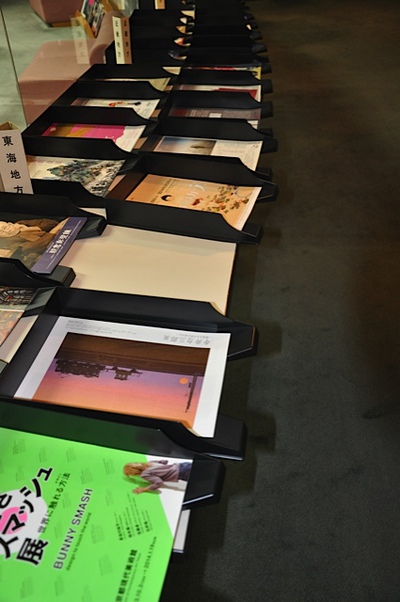

I’ve always been very impressed with the very high standard of painting by amateur artists in Japan. This is self evident when visiting the many exhibitions in the annex, so when visiting


Takamatsu and the gallery please take the time to both visit the annex and enjoy the meditative and relaxing atmosphere.

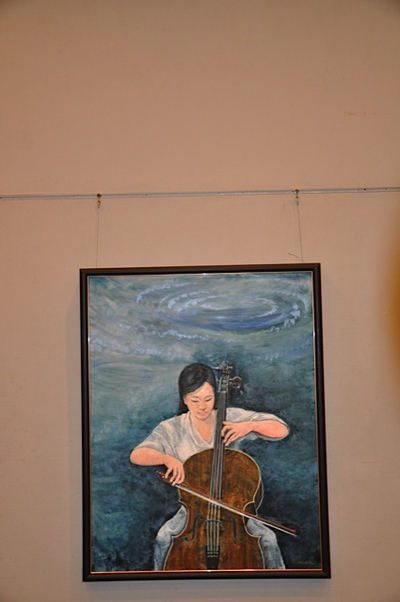

Other bloggers in Takamatsu of interest:
http://cathy.ashita-sanuki.jp
http://ogijima.com
http://ww8.tiki.ne.jp/~tmath/home/
Where we are:
http://wikitravel.org/en/Takamatsu
http://www.city.takamatsu.kagawa.jp/english/
http://www.my-kagawa.jp/special/visitor/kanko/index.htm
http://www.i-pal.or.jp/profile/topics/kagawas-welcome-card.html
http://www.city.takamatsu.kagawa.jp/12754.html


http://www.city.takamatsu.kagawa.jp/english/sightseeing/sees/takamatsu-city-museum-of-art.html
This is a gallery that has been built in the very heart of Takamatsu which says much about the priorities of culture above commerce and sensible city planning. It is absolutely always a pleasure to drop in.

The internal environment of the gallery has been carefully thought out to work with the outside landscape and in a busy city provide some rest for the mind.

Upstairs on the 2nd floor is a public library with a very wide selection of reading materials on modern art, contemporary Japanese art, Western & oriental art. It really is quite wonderful to sit here and browse in the very comfortable surroundings.

But this time I want to talk about the annex in the gallery which holds exhibitions year round for the different art groups here in the city. Access to the annex just inside the south entrance and the admission is free.


I’ve always been very impressed with the very high standard of painting by amateur artists in Japan. This is self evident when visiting the many exhibitions in the annex, so when visiting


Takamatsu and the gallery please take the time to both visit the annex and enjoy the meditative and relaxing atmosphere.



Other bloggers in Takamatsu of interest:
http://cathy.ashita-sanuki.jp
http://ogijima.com
http://ww8.tiki.ne.jp/~tmath/home/
Where we are:
http://wikitravel.org/en/Takamatsu
http://www.city.takamatsu.kagawa.jp/english/
http://www.my-kagawa.jp/special/visitor/kanko/index.htm
http://www.i-pal.or.jp/profile/topics/kagawas-welcome-card.html
Grandma Moses in Takamatsu
2013年10月08日
The style is instantly recognizable, odd perspective, something between naivety & insight, perhaps even both and it was wonderful to see here in this city.


Anna Mary Robertson Moses, better known as ‘Grandma Moses’ was and of course still is and American phenomenon in the art world. Countless postcards, Life and Look magazine covers with American themes, often rural, is always championed as the embodiment of; ‘it’s really never too late to start anything at all.’ Moses started painting late in life and the lack of academic training as she was self-taught, was her asset rather than any hindrance.


I was a little taken aback, as the colors of the original paintings are not as vivid as they’ve appeared in reproductions. Rather muted and not the bright colors I’d expected at all. Picasso one said he liked to see reproductions of his own works as the colors were different, sometimes completely so and gave him fresh ideas.

Spry and highly productive, Grandma started out with embroidery and turned to painting to make Christmas gifts.

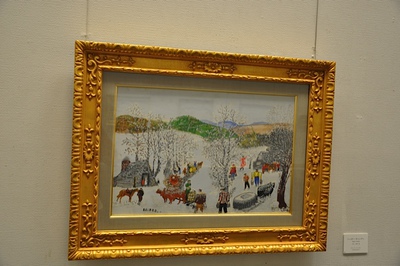
Usually thematic and often with winter scenes, the pictures show an America that is slowly disappearing. Grandma has always been well received in Japan and now that the exhibition is here in Takamatsu until the middle of the month, please do drop in to our wonderful Takamatsu Gallery and see it.





Concurrently there are other works in this same show by both European & Japanese artists. So I’ll be back soon with more news from our city on art and other themes so until then and remember it’s really never too late to start anything. Grandma Moses did and so can you ..
http://www.city.takamatsu.kagawa.jp/12754.html
Other bloggers in Takamatsu of interest:
http://cathy.ashita-sanuki.jp
http://ogijima.com
http://ww8.tiki.ne.jp/~tmath/home/
Where we are:
http://wikitravel.org/en/Takamatsu
http://www.city.takamatsu.kagawa.jp/english/
http://www.my-kagawa.jp/special/visitor/kanko/index.htm
http://www.i-pal.or.jp/profile/topics/kagawas-welcome-card.html


Anna Mary Robertson Moses, better known as ‘Grandma Moses’ was and of course still is and American phenomenon in the art world. Countless postcards, Life and Look magazine covers with American themes, often rural, is always championed as the embodiment of; ‘it’s really never too late to start anything at all.’ Moses started painting late in life and the lack of academic training as she was self-taught, was her asset rather than any hindrance.


I was a little taken aback, as the colors of the original paintings are not as vivid as they’ve appeared in reproductions. Rather muted and not the bright colors I’d expected at all. Picasso one said he liked to see reproductions of his own works as the colors were different, sometimes completely so and gave him fresh ideas.

Spry and highly productive, Grandma started out with embroidery and turned to painting to make Christmas gifts.


Usually thematic and often with winter scenes, the pictures show an America that is slowly disappearing. Grandma has always been well received in Japan and now that the exhibition is here in Takamatsu until the middle of the month, please do drop in to our wonderful Takamatsu Gallery and see it.





Concurrently there are other works in this same show by both European & Japanese artists. So I’ll be back soon with more news from our city on art and other themes so until then and remember it’s really never too late to start anything. Grandma Moses did and so can you ..
http://www.city.takamatsu.kagawa.jp/12754.html
Other bloggers in Takamatsu of interest:
http://cathy.ashita-sanuki.jp
http://ogijima.com
http://ww8.tiki.ne.jp/~tmath/home/
Where we are:
http://wikitravel.org/en/Takamatsu
http://www.city.takamatsu.kagawa.jp/english/
http://www.my-kagawa.jp/special/visitor/kanko/index.htm
http://www.i-pal.or.jp/profile/topics/kagawas-welcome-card.html
Welcome to the Small World
2013年03月10日
 At the Takamatsu City Museum of Art there’s a very interesting show running until March 24th titled, ‘Welcome to the Small World’.
At the Takamatsu City Museum of Art there’s a very interesting show running until March 24th titled, ‘Welcome to the Small World’.This is a wonderful encounter with 5 contemporary Japanese artists using ‘small’ as the thematic introduction to their art.


Small everyday articles, for example jewelry, cellphone accessory doo-dads, miniature furniture with candy decorations all worked in a way to take us visually, in to the artists’ worlds. The artists have incorporated & collaborated their art with the collection already in the gallery. I didn’t really get this, but that’s what they’ve said on the brochure.
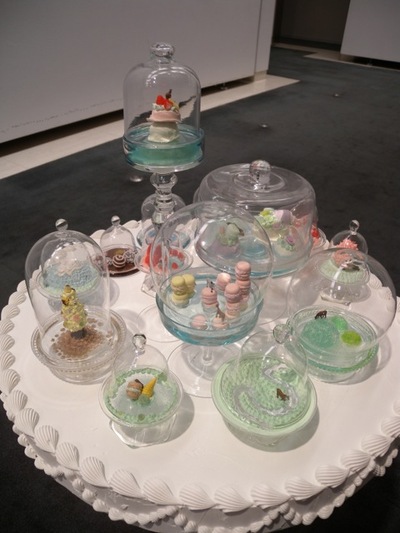
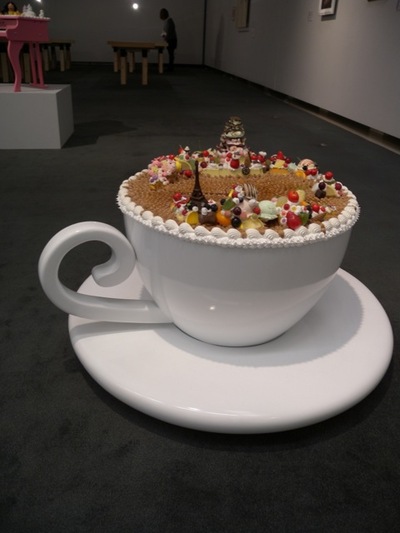
Zon Ito: (male) has about 100 objects on display with the titles named. So rather than describe the works, I’d like anyone reading this and in town to go see for themselves as it’s an interesting piece.


Yoshiaki Kaihatsu: has tearooms, something traditionally associated with ‘small’ in Japanese culture. He’s made these from styrene blocks and the effect is great. Impermanence, the lowering of the head to enter the confined space, reflection in silence, all aspects of ego subjugation & part of the way-of-tea culture. And here we see it but in the form of styrofoam making things even more impermanent. But wait a minute? Styrofoam lasts for centuries I heard so maybe not so impermanent after all?
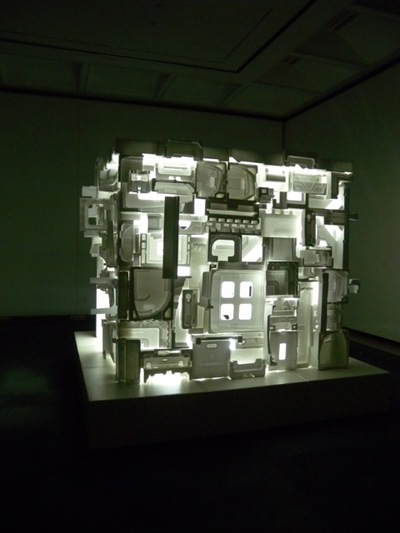
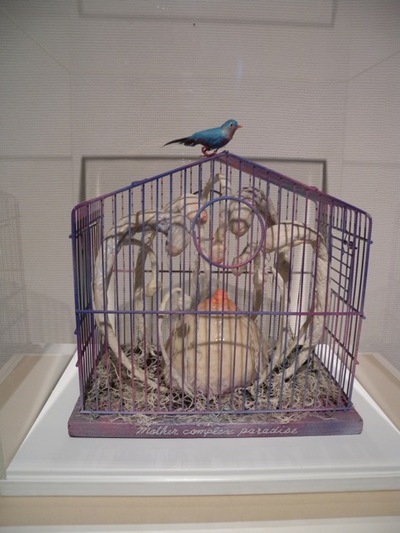
Yoshihiro Tsuda: Has placed flowers all over the gallery. Some are carved in wood, others located out of the line of sight.

Yuken Teruya: (male) has created works made with or from daily goods such as paper bags from fast-food shops. The artist is concerned with the economy, the environment and wants to turn people’s attention to the same.
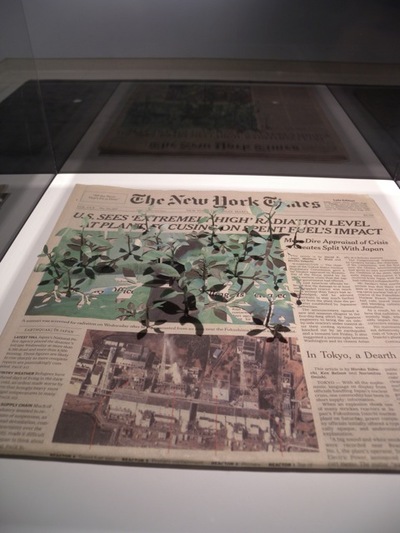

Osamu Watanabe: These sculptures remind me of Jeff Koons an American artist famous for making objects that either reflect the banal, or are of themselves just banal. Depending on your feelings towards Koons. Colorful, and the media are food, sweets and fruit.


Please drop in and see this show as it’s a good ‘un and a precursor to the big Setouchi Triennale starting at the end of this month.
I’ll be back then with lots & lots of art news again soon so until then ..
‘Welcome to the World of Small’ Takamatsu City Museum of Art
http://www.city.takamatsu.kagawa.jp/english/sightseeing/sees/takamatsu-city-museum-of-art.html
Runs until March 24th.
Schedule: 3/16 The Concert 13:30~14:00/ entrance hall/ admission free
Sundays & public holidays.
Gallery Talks and explanations about the exhibits by volunteers in the gallery.
Starts. 11:00 and 14:00
3/23 ‘Lets Play with Art’ art appreciation for kids
9:00~11:00 at the lecture room on the 3rd floor.
First 15 free (ages from elementary school grades 3 to 6)
Application by phone: 087-823-1711
Coming attractions: Cheburushka and the animations in Rosia picture books
4/6~5/19
15 minutes on foot from Takamatsu JR Central Station.
Underground parking
http://wikitravel.org/en/Takamatsu
http://www.city.takamatsu.kagawa.jp/english/
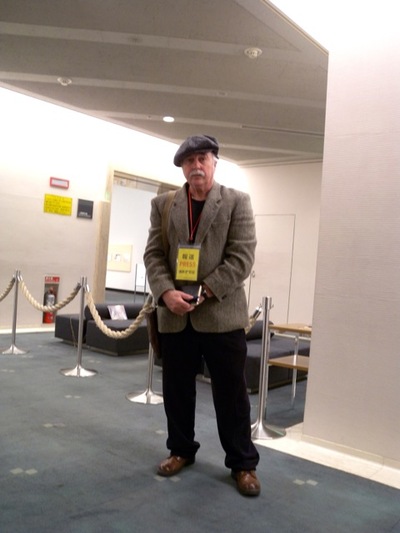
ART PROJECT IN YASHIMA
2013年01月25日

The Yashima area has taken a business/art initiative to promote artists and artisans in the area with Yashima as the central theme.
The Seto Inland Sea Triennale will be here in the summer, and given the runaway success of the first event in 2010, we expect this one to be even bigger and more popular.
http://setouchi-artfest.jp/en/
I covered it in 2010 for the city’s art pages and wrote it up for some foreign media, and I’m looking forward to the same privilege with my pal Cathy Hirano (Cathy’s blog) http://cathy.ashita-sanuki.jp/e273179.html this year too.
We had a lot of fun in the summer of 2010

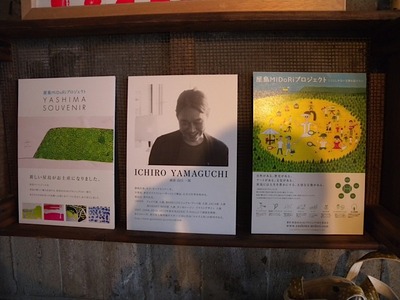
The current movement in Yashima is a kind of warm-up event and a group of the residents started projects such as ‘Yashima souvenirs’ all designed with Mt. Yashima & the Inland Sea as direct motifs or the mountain as an abstract theme for many of the articles themselves.


The art goods are all now available in the Kitahama Alley area of the Takamatsu Port.
http://www.kitahama-alley.jp
http://www.city.takamatsu.kagawa.jp/english/sightseeing/eats/kitahama-alley.html
If you check through my past blog 2010/7/29, you’ll find the one on this remarkable old part of town. Now gentrified and at the same time keeping the atmosphere and ambience of the past. It’s a special place in Takamatsu.
http://pat.ashita-sanuki.jp/d2010-07.html

Another group involved with the project is from Kagawa University. They’ll hold coffee shops and concerts for the festival in the summer.


Another feature will be night tours of Yashima, and if you’re travelling to Japan then Takamatsu should be on the itinerary as we’re easy to access by train, plane or ferry from Osaka, or anywhere on Honshu (the main island).
The first Yashima night tour will be held on the 26th of July and there will be three in total.


The tours will run from 5:30~9:00 pm and will cost ¥1,000 which will include and ‘obento’ lunch box and this is a reasonable fee indeed ...
Kagawa University can be contacted on this number for information about these tours.
087-832-1000

So I’ll post a few more pictures here of the Kitahama Alley shops and their display of some of the art works available. At the bottom are two links to help you know where we are and what a great place this is to visit.
http://wikitravel.org/en/Takamatsu
http://www.city.takamatsu.kagawa.jp/english/
See you then and until next month, please stay warm. And remember Spring is coming soon.
Art in Takamatsu part2
2012年11月29日
 On assignment for Art in Takamatsu this summer, we 3 bloggers for the City’s offices visited the Folk House Open-air Museum and Gallery aka Shikoku Mura.
On assignment for Art in Takamatsu this summer, we 3 bloggers for the City’s offices visited the Folk House Open-air Museum and Gallery aka Shikoku Mura.http://www.japan-guide.com/e/e5402.html
http://www.shikokumura.or.jp/english/index.html


Located in Yashima and a 10 minute walk from Yashima Station the facilities are open year-round with and adult fee of 800 yen and
As the brochure given us at the entrance says, this is a step back in time to scenes of traditional Japan and an encounter with a bygone era.


Most of the thirty-three traditional buildings have been relocated and the Shodoshima Farmers’ Kabuki Theater is s splendid example of Japanese architecture from more than 200 years ago.


Once these theaters were in many places in the countryside in Shikoku to provide entertainment for the farmers and countryside people in much the same way as TV does now I suppose.


The Soy Sauce warehouse and malt house/brewery was of great interest with its traditional implements for brewing soy. I could easily imagine the toil and effort needed to make the things we now take for granted as commodities.


So to see how the people lived in the past, this is a great place to visit and there are brochures in other languages including English for visitors.




I’ll be back for a few blogs in December. As the seasons change, please keep warm and until then ..
Art in Takamatsu
2012年11月26日
 As the intro to our site says, Takamatsu is a city full of art and this time I’d like to introduce you to a creative group calling themselves ‘Theater Tank’ working out of Shikoku University which isn’t quite in Takamatsu, but not very far away in the small town of Zentsuji, Kagawa.
As the intro to our site says, Takamatsu is a city full of art and this time I’d like to introduce you to a creative group calling themselves ‘Theater Tank’ working out of Shikoku University which isn’t quite in Takamatsu, but not very far away in the small town of Zentsuji, Kagawa.
Maya Sakamoto is on the staff of the university and kindly gave me some photos (and aren’t they remarkable?) to post for our blog.
‘Theater Tank’ is as the name implies, a collective body of both staff & students using choreography, lighting, dance and theater as the stage for their interesting projects. Well perhaps they’re more than just ‘intersting’ they look quite exiting, frankly. Walking on eggs has always been an image I can relate to with my occasional stumbles through this vast tapestry we call ‘life’s journey.’
Maya is working with other staff and majors to perform Hamlet in 15 minutes (sic) this will be interestin’ indeed. But I digress, as the troupe are seasoned and dedicated to performance-as-art and if the quality of the photos she sent me are anything to judge by, we’re in for a good show.
More information in Japanese is available here.
http://www.sg-u.ac.jp/view.rbz?cd=1119
Hamlet is tentatively on the list for this show. The other acts/performances will be, ‘My Laughing Voice Glowed up with Naked Feet’ Direction. Nami Akiyama
‘Theater Improvisation’
Direction: Sengoku Keiko
‘Tamago-Egg’
Choreograph: Maya Sakamoto
The shows are running from 1012 December 13thThur. (7 pm) 14th Fri. (7 pm) Sat. 15th (2:00 pm)
*Notos Studio in Shikoku Gakuin (university)
3-2-1 Bunko cho
Zentsuji
Kagawa.
The admission is free but please make a reservation by phone or email.
sokyoken@sg-u.ac.jp
Tel: 0877-62-2455
*I’ll be back and looking at more art in the city and also at some alternative life-style people who are making their way to the prefecture to develop their art & lives here in the unique environment that we have. See you then and stay warm.
ART in TAKAMATSU
2012年10月29日
 Sometime in 2004 I took a trip to the Mori Tower gallery in Roppongi Hills, Tokyo to see the Kusamatrix Exhibition, which featured, among others, the art of Kusama Yayoi. She turned up in her permanent red wig and wheelchair to the show.
Sometime in 2004 I took a trip to the Mori Tower gallery in Roppongi Hills, Tokyo to see the Kusamatrix Exhibition, which featured, among others, the art of Kusama Yayoi. She turned up in her permanent red wig and wheelchair to the show.

Now a living legend, fabulously wealthy and fulltime resident (by choice) at a mental hospital in Tokyo. ‘The dot lady’ as I’ve always thought of her, is a woman living on the very edge of reality/insanity and we’re all the richer for it. Perhaps it’s from this place on the precipice of the know and the unknown & staring into the great singularity that she’s capable of seeing & painting the world she describes;


“Red, green and yellow polka dots can be the circles representing the earth, the sun, or the moon. Their shapes and what they signify do not really matter. I paint polka dots on the bodies of people, and with those polka dots, the people will self-obliterate and return to the nature of the universe.
An excerpt from “Infinity Nets”, Kusama Yayoi Autobiography

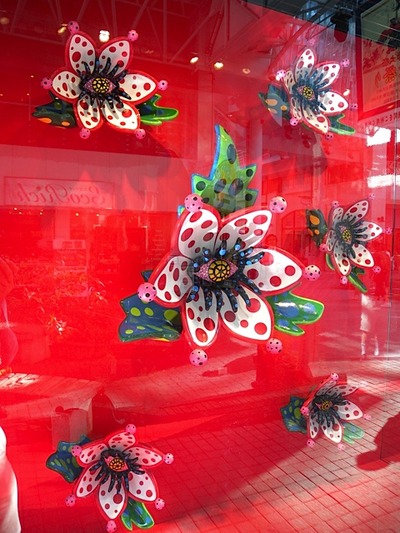
Well, she’s in town in the form of window-dressings for one of Takamatsu’s largest and best known department stores right in the heart of town. More to the point, she’s accepted design commissions from the swank French bag makers, Louis Vuitton.


Art-as-industry, this must be a lucrative deal for both indeed. Kusama’s art fetches millions for single paintings and with the help of numerous assistants that all big-time artists utilize, she really cranks this stuff out.


What I liked was the use of the ‘light-box’ technique to photo her bags etc. The Canadian artist Jeff Wall is very skillful with this and he has produced some stunning stuff such as this ‘a sudden gust of wind (after Hokusai) based on one of Hokusai’s Edo era woodblock prints.
http://www.artfund.org/what-we-do/art-weve-helped-buy/artwork/5504/enlarged/1/a-sudden-gust-of-wind-after-hokusai
Wall uses the same technique of fluorescent lights behind photos printed on large sheets of plastic & there is such a wonderful pull into the visual area with this. Don’t trust me, go take a look, please ..


I took my wife to Osaka before spring to see her solo show at the Osaka Art Gallery and broke protocol by taking a few quick snaps, which are posted here.

I’ve never really understood if Yayoi is just nuts, a shrewd marketing force, or both? Perhaps it really doesn’t matter.
Anyway, please take a look at this when you’re in Takamatsu as it really is a good show and what’s more it’s free.
I’ll be back with more about Takamatsu and art in a couple of weeks. Until then, keep smiling, safe and warm …
タグ :Osaka
ART in SAKAIDE CITY
2012年09月26日

“Gem”(noun) ‘Definition; something beautiful or outstandingly good. Often left undiscovered’
And that’s just what the Yotsuya Simon Doll House in Sakaide City is.


Tel: 0877 45 1111 open Tuesdays, Thursdays and Saturdays and within walking distance from Sakaide JR station. Open from 10:00~16:00.
500-yen adults


This exhibit just blew me away with the intoxicating imagery. Not much abstraction but a very dramatic, part fantasy, raw and direct observation of the human form through the medium of dolls and at times amusing. Quite possibly the most powerful look at the human form I’ve ever seen anywhere and I’ve looked at quite a lot over many years. The only comparison I could come up with was the Australian artist Lutz Presser for similarities. http://www.lutzpresser.com/mp.htm


The museum is staffed by a lovely woman who took a lot of trouble explaining things to me and she obviously feels very passionate about the works and the owners, the remarkable Kamada family. Makers of high-quality soy sauce and Japanese food products for centuries. The Kamadas are well known for both their philanthropy and contributions to the arts here in Kagawa prefecture.


After a few minutes here, I realized that I was actually in a ‘dolls house.’ This is where they lived and I was the guest. I’m a little slow to catch on, as it took me a few minutes to wake up to that and from then on I saw the works in a different way.


The first doll at the entrance was the huge man in a bowler and Rene Magritte must have inspired the figure.


I won’t go on trying to explain about this wonderful gem I found but urge anyone with an interest in art to go see this amazing exhibition. It will speak for itself and a few months after my visit I’m still thinking about it.


So until next month, enjoy the cooling breezes and see you then. Thanks for taking the time to read the blog.
Pat
RITSURIN, IRISES & a CLOSER VIEW
2012年06月04日
Ama agari nanairo fukashi hanaayame
雨上がり七色の深し花あやめ
‘Irises, more rainbow colored after the rain’
I can’t remember who wrote this but it’s a perfect haiku for another look at our beloved Ritsurin Garden in Takamatsu.
Now’s the season for irises and they’ll be out in a few days. Van Gough had a thing for them too and little wonder, as their beauty is so attractive. Van Gough’s captured this with his own distinctive energy. Something between passion & ecstasy and at times just bordering on radioactive ..



Well they’re now out and here for all of us to see and enjoy. While I was there I imagined they were letting out little sighs of disappointment to each other and whispering; “why are we blooming for this old fool?”

bring myself here to paint often and I met this familiar face on a previous occasion and offered a few tips on iris painting.
Lot’s of こもれび (komorebi) (light filtered through leaves) here which I wrote about last month and just love to enjoy.

This is such a good time to do things like paint, and it really doesn’t matter if you’re good or not as it’s irrelevant and besides the pleasure is just so great. I’m sure this young woman friend was enjoying her own painting session just as much as we were.


Ritsurin is a garden of moods, seasons and ever changing aspects. Every few meters or so, the ‘aspect’ changes and that’s a part of it’s design I heard. Much of what we can see here is smaller, less obtrusive and whilst not hidden, obverse in the sense that while it is turned towards the observer, takes a little time to find and away from the recognized scenic spots there.
How many shades of green can you see in the patina of the bronze bridge post cover? Lots, I’m sure … it’s the less obtrusive stuff in Ritsurin that I dig and would like to share.



I'll be back with another blog for the city soon. So until then, please go and enjoy the irises and the smaller, less obtrusive beauty of this place.Take along your watercolors and paint away. Oh, and keep all those comments and letters coming in. Until then ..
THE ART OF PARKS
2012年03月15日

Tamamo Park is another favorite place of mine and now that Spring has arrived, the annual sale of trees, plants and shrubs there by vendors has started. This is known as a “sea castle” and there are only a few in Japan. 80,000 square meters and built in 1590 for the Ikoma family, later ruled by the Matsudaira family for 11 generations and who ruled Sanuki (Kagawa) for 228 years.

TamamoPark
It’s so close and central and such a relaxing place to be for reflection, meditation or just simple good old peace-and-quiet. We can see the history museum right next door, too. I heard there are a few categories of Japanese parks and this one, like Ritsurin its world famous peer has ‘aspects’ that change every few meters.
Walk twenty meters or so and you’re in a different aspect. A different park … at times, totally different actually. So please keep this intentional design feature in mind when you’re walking around.
For me, the park has the most beautiful stonework from the remains of the castle once there. I took some photos, which I hope will show this lovely balance of soft and hard. Plants, trees and against stonewalls softened with such graceful curves as they meet the ground.
The at times, greenish colored stones themselves have weathered and slightly rounded their edges over the centuries. This used to be a place with lots of moats. Tons of them, so water is still a central part of its ‘aspect’ and overall design. 3 big ones in fact, an outer, middle and inner moats so there’s a lot of water and sluices and sluice gates for controlling all this water. They must have felt very threatened in those days? Or very secure? Can’t figure out quite which … both? It does explain the signs references to traditional Japanese swimming, which must have been practiced in the inner moat. (My conjecture)
On the south side are the last intact remains of the old castle’s turret or guardhouse and it’s beautiful to sit there and look at the park, cherry blossoms and to the north, the Inland Sea.

Tamamo Park also has apart from a lot of moats and water, some beautiful Tasiho era buildings, which still serve the public with occasional exhibitions, tea ceremonies and concerts.
The park operates all year but opening times may vary seasonally. But it usually opens from 7:00 A.M until 5:00 P.M. It’s directly across from the Central Takamatsu JR Station and about 5 minutes on foot. Tel: 087 851 1521 You’ll need a Japanese friend to advise you of the events being held there, so do take the time to find out as there have been some great bonsai exhibitions, moon-viewing parties etc. in the past.
There are quite a few signs in English explaining the history of the place and this makes it friendly for English speaking visitors.
Entrance fee: 200-yen adults. Children 160-yen. Cheap.
At the moment, there’s rebuilding going on of one of the stonewalls on the south side. Nobody has a clear idea of the exact scale and dimensions of the previous castle most of the old records have been lost. Sad …
KANA HONDA EXHIBITION
2012年03月10日
 Walking around the streets of our Takamatsu sometimes turns up little surprises. By chance I found an interesting exhibition of photos by Kana Honda at the Tokiwa Gallery in the city.
Walking around the streets of our Takamatsu sometimes turns up little surprises. By chance I found an interesting exhibition of photos by Kana Honda at the Tokiwa Gallery in the city.http://www.hondakana.jp/biography/index/en/


Born in Tokyo in 1970 Kana Honda has picked up several awards and citations in her career. She’s had solo exhibitions in Paris, Tokyo, Kyoto, the USA and Italy. Quite impressive for someone still relatively young.


What really caught my attention with this exhibition is they way she’s used textures and juxstopositioned conflicting perspectives into one another. I’ve not really seen this before, with perhaps the possible exception of David Hockney. But this is a bit different from Hockney’s use of cut out photos pasted on board and canvases. The woven effect or ‘Photo Cross’ as she calls it, is very subtle and she does some interesting things with photos unlike anything I’ve ever seen before.


Comparisons don’t come easily with Kana’s work. Oscar Oiwa is one of the few that do come to mind. The Brazilian Oiwa, a 3rd generation Japanese Brazilian now living and working in NY had a beautiful installation/painting on Ogi Island just a short hop from Takamatsu, which was sadly lost to a fire shortly after the Seto Uchi Art Festival in 2010. Oiwa has such a playful and fresh way of looking at Japan and the retrospective he held in Takamatsu a couple of years ago was a knockout show. Witty, playful, fantastic and often dark but always thought provoking.
http://www.oscaroiwastudio.com/
So if you’re in town this month please drop in to the Tokiwa Gallery for a look-see.




I’ll be back next week with more exciting stuff for you so in the meantime, please keep all those cards and letters pouring in …
The Circle of Life
2012年02月20日
I know, I know, I really did promise to be back here this week with art updates and I will but the opportunity to present a rather remarkable young man’s 88 temple pilgrimage circling around Shikoku was too much to pass up. Ryan Armstrong is a former colleague in the International Affairs Division, great sportsman, excellent dad and all-round gentleman. And … a great bloke to boot. I’ll let him tell the story replete with his magnificent photos for you and include his web address as well:
Through Henro Eyes by Ryan Armstrong
“The world is simple and pure through pilgrim (henro) eyes -- 50,000 steps; a walking stick; a daily marathon of solitary contemplation.
My walking stick (Otsue) braced me along rocky paths and stabilized slippery ground. It helped me up mountains and supported me down. The sutra on my Otsue provided mental exercise during long days and the feel of smooth wood offered familiarity during an unpredictable journey. Its every clack, 50,000 times, beat out a rhythm that moved me through another day afoot. The walking stick became my companion and partner on the Shikoku 88-Temple Circuit.

The Tools
Without time or date
Hat, stick and self
The Henro is a simple feat
I first ventured to Shikoku after hearing my college sempai say, “It’s too difficult, don’t do it.” His words, cautionary though they were, became my motivation for walking the 1200km route. Later, my objectives evolved as I sought to learn about myself and experience the traditional side of Japan.

The Marble Reflection
Along the pilgrim’s path
Did you meet the Daishi?
Yes, everyday.
I walked the pilgrimage twice, once forwards and once backwards. Both times ‘dogyo ninin’ and Shikoku’s ‘osettai no kokoro’ helped me complete my journeys.

The Mossy Wall
On the Henro
Moss and walls became my canvas.
The sun became my paint.
Always at my side
But never within reach.
In times of need
It touched my soul.
The Shadow of a Pilgrim.
'Dogyo ninin' describes the relationship between the henro and Kobo Daishi, who is embodied by the Otsue. Literally meaning, 'two people go together,' dogyo ninin and signifies how Kobo Daishi helps the henro in times of need.
For me dogyo ninin manifested itself as a growing sense of appreciation.

Happy Jizo
Can you feel the warmth of a cold stone face?
Osettai no kokoro, on the other hand, is about kindness. In the less-traditional Japanese world, osettai means wining and dining clients, but on Shikoku it means giving a gift to a henro without desire for anything in return. There are people who cannot do the pilgrimage for whatever reason -- job, health, whatever -- and this is how they participate.
One day, I was walking along a road. A man passed me in his car on his way to work and yelled “gambatte!” In the evening that same driver was going home and passed me again. Later, he drove back and gave me a bag of oranges and 1,000 yen for dinner. He said he had seen me while he was going to and from work, and he wanted to help.
I received countless gifts and constant cheers of support. I was invited to bathe and even sleep in people's homes. These kindnesses had the power to turn my day around and enable me to take one more step towards my goal.
Through Shikoku’s ‘osettai no kokoro’ I learned the effects simple acts of kindness can have on a person.

The Tent Guy
A man with no tent.
The gift of giving a gift -
Who gave us such luck?
When a pilgrim walks, temples make up one percent of the henro’s time. The rest of the time is spent traveling between temples. Thus, it's the pilgrim’s path, not the temples themselves, that makes the pilgrimage.
Still, there's one fundamental lesson I gleaned from my two distinct pilgrimages.
It all boils down to doing one’s best to live in the moment by appreciating the small things. The flower on the side of the road, the rainfall, the smile from a stranger. Good days come and go, and bad days do the same.
After a long mountainous climb I took a picture of my footprints, which were made from sweat. Through my pilgrim’s eyes, I relished that scene and thought, 'In 10 minutes they'll be gone.’

”Life is fleeting. Catch it while it's there.”
www.circle88.com
Thanks Ryan … and I’ll be back in a couple of weeks with more and of course that promised art update, which I’m working on. Keep all those cards n’ letters coming in and send me a letter if you’re interested in anything you’d like to hear about from Kagawa. I’ll answer you for sure. Until then.
Through Henro Eyes by Ryan Armstrong
“The world is simple and pure through pilgrim (henro) eyes -- 50,000 steps; a walking stick; a daily marathon of solitary contemplation.
My walking stick (Otsue) braced me along rocky paths and stabilized slippery ground. It helped me up mountains and supported me down. The sutra on my Otsue provided mental exercise during long days and the feel of smooth wood offered familiarity during an unpredictable journey. Its every clack, 50,000 times, beat out a rhythm that moved me through another day afoot. The walking stick became my companion and partner on the Shikoku 88-Temple Circuit.

The Tools
Without time or date
Hat, stick and self
The Henro is a simple feat
I first ventured to Shikoku after hearing my college sempai say, “It’s too difficult, don’t do it.” His words, cautionary though they were, became my motivation for walking the 1200km route. Later, my objectives evolved as I sought to learn about myself and experience the traditional side of Japan.

The Marble Reflection
Along the pilgrim’s path
Did you meet the Daishi?
Yes, everyday.
I walked the pilgrimage twice, once forwards and once backwards. Both times ‘dogyo ninin’ and Shikoku’s ‘osettai no kokoro’ helped me complete my journeys.

The Mossy Wall
On the Henro
Moss and walls became my canvas.
The sun became my paint.
Always at my side
But never within reach.
In times of need
It touched my soul.
The Shadow of a Pilgrim.
'Dogyo ninin' describes the relationship between the henro and Kobo Daishi, who is embodied by the Otsue. Literally meaning, 'two people go together,' dogyo ninin and signifies how Kobo Daishi helps the henro in times of need.
For me dogyo ninin manifested itself as a growing sense of appreciation.

Happy Jizo
Can you feel the warmth of a cold stone face?
Osettai no kokoro, on the other hand, is about kindness. In the less-traditional Japanese world, osettai means wining and dining clients, but on Shikoku it means giving a gift to a henro without desire for anything in return. There are people who cannot do the pilgrimage for whatever reason -- job, health, whatever -- and this is how they participate.
One day, I was walking along a road. A man passed me in his car on his way to work and yelled “gambatte!” In the evening that same driver was going home and passed me again. Later, he drove back and gave me a bag of oranges and 1,000 yen for dinner. He said he had seen me while he was going to and from work, and he wanted to help.
I received countless gifts and constant cheers of support. I was invited to bathe and even sleep in people's homes. These kindnesses had the power to turn my day around and enable me to take one more step towards my goal.
Through Shikoku’s ‘osettai no kokoro’ I learned the effects simple acts of kindness can have on a person.

The Tent Guy
A man with no tent.
The gift of giving a gift -
Who gave us such luck?
When a pilgrim walks, temples make up one percent of the henro’s time. The rest of the time is spent traveling between temples. Thus, it's the pilgrim’s path, not the temples themselves, that makes the pilgrimage.
Still, there's one fundamental lesson I gleaned from my two distinct pilgrimages.
It all boils down to doing one’s best to live in the moment by appreciating the small things. The flower on the side of the road, the rainfall, the smile from a stranger. Good days come and go, and bad days do the same.
After a long mountainous climb I took a picture of my footprints, which were made from sweat. Through my pilgrim’s eyes, I relished that scene and thought, 'In 10 minutes they'll be gone.’

”Life is fleeting. Catch it while it's there.”
www.circle88.com
Thanks Ryan … and I’ll be back in a couple of weeks with more and of course that promised art update, which I’m working on. Keep all those cards n’ letters coming in and send me a letter if you’re interested in anything you’d like to hear about from Kagawa. I’ll answer you for sure. Until then.
AJI STONE
2012年01月30日
 To the East of Takamatsu about 30 minutes by bus, maybe a little more, is the small town named Aji. Right in the heart of Japanese medieval history’s great Dan-no-ura battle this is a town that has a strong ambience of things past, deep culture, granite rocks and the salty smell of the sea. Bracing indeed …
To the East of Takamatsu about 30 minutes by bus, maybe a little more, is the small town named Aji. Right in the heart of Japanese medieval history’s great Dan-no-ura battle this is a town that has a strong ambience of things past, deep culture, granite rocks and the salty smell of the sea. Bracing indeed …

These days it's the home to a great many stone masons who’ve hauled rocks from the nearby mountains and the whole area looks like one big rock pile with cranes trucks and the sound of drills and chisels. In fact that’s about all there is and that’s praise not a slight, I love it because there are so many interesting exhibits in the stonemasons’ yards.




The sculptures are for sale and/or by commissions; they range from the pious to the less reverent, odd and at times downright witty. The Kitty Chan grave marker as one example along with ready-to-strike arm and hammer in the tradition of North Korean and other Marxist heroic sculpture. Tantalizing stuff for a bourgeoisie blogger with a sense of humor


Everywhere in Aji is the feeling that the sea is close by and of course that’s because it is. The sea and this ambience of history make this a great town to just stroll around in. Not many cars here and we can take in the Isamu Noguchi Studios (and what an visual adventure that is …) I already knew Noguchi was a brilliant artist from art history studies and probably at the top here, and can only marvel at his refined sense of aesthetic and self-discipline. The man was constantly working, evolving, switching media and was attracted to this area to sculpt and build such a magnificent studio compound. I’ll write two articles about Aji, this the first as a precursor to another that will look more closely at the work coming out of the town. Later I’ll try to deal with some of the individual craftsmen and artists there.










There is a sculpture walkway here and many signs in English.
I’ll be back in a couple of week, so please keep you comments, cards n’ letters coming in. Until then ….
BONSAI ARTIST & MAINTENANCE
2011年12月15日
It was almost dark and the wind had picked up as I left JC's waterside haunt. It was another tough assignment and I pulled up my collar and rode off into the night thinking. Bonsai…? Time to redirect tension and stress and get some nitty-gritty technical info on this bonsai stuff.
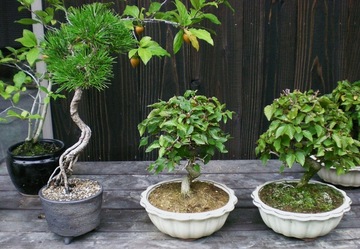
A couple of blogs before, we introduced you to a talented Frenchman and bonsai artist Xavier Brusset. He’s also really nice bloke and offered to help me with the technical aspect of this art and he offered advice on maintenance, watering etc. Xavier said that the shaping of bonsai, which I thought it was all about, is only one small part of it and that there’s no ‘meaning’ to creating nice bonsai if you’re not able to take care of them properly and not let them die.
He said at the basic level, important techniques are; trimming, bud cutting, repotting, pruning, fertilizing but the one most important one is the watering.
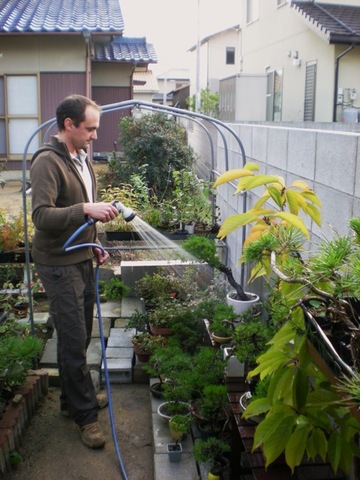
He went on to say that the frequency which we need to water, depends on the species, weather, the soil itself, size and stage of growth of the plant. The basic rule is to water when the substrate (I had to look that one up in the dictionary) is dry. In Kagawa’s summer that’s easy. He told me as it’s hot, so the best times are the mornings and evenings and to avoid midday when the sun is at it’s strongest and the plants adapt their morphology (I had to look that one up too) and that fresh water at this time could change it.
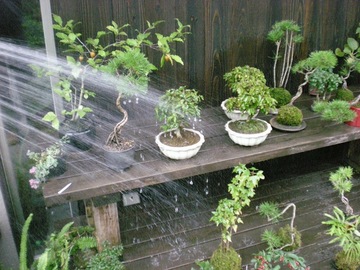
The other seasons need more careful observation by looking at the soil or the color of the leaves. So in Kagawa it’s a rule of thumb to water once a day or every other day in autumn. In winter about once a week but that we have to be careful as the wind is sometimes dry and that would require another day’s watering.
Xavier said that the other important points are the amount of water we need and to wait until the water gets out from the drain hole at the bottom of the pot. The other one is not to obstruct the drainage, so we need to be careful by using under-plates, the roots could rot if the substrate is always soaked.
Also don’t water just the soil, as the foliage also needs it. During the summer, at the end of a hot day it’s helpful to improve the effect of the dew. And also ‘wash’ the tree, to get rid of any insects and dust.
http://midoridesign3ki.blogspot.com/
So basically, that’s the way it is here in Kagawa and the northern hemisphere. Let’s now go south to Australia to see how another talented bonsai artist does things in a very different environment.
Jason Pover was a resident in Kagawa and studied bonsai his ‘hobby for life’ here with Xavier. He says now his trees are different but the passion is the same. I asked Jason for some tips and he’s offered to tell us something about pruning and I’ll let him use his own words;
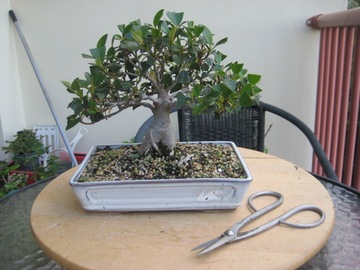
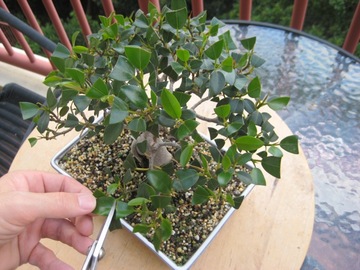
“The main reasons for leaf pruning bonsai are to produce a smaller crop of new leaves, to let light reach the inner and lower branches and to gain an extra year's growth. With a second flush of new leaves, the autumn colour is also improved. Next year's buds will be activated and therefore the development of the bonsai is rapidly speeded up. Damaged or scorched leaves can be replaced with fresh new leaves; weak areas of branches can receive more light and ventilation improving the overall health of the tree. This practice is commonly done in Australia on different types of ficus to help reduce the size of the leaves and keep them in proportion with the tree. The benefits are very obvious on a mame or shohin size bonsai.
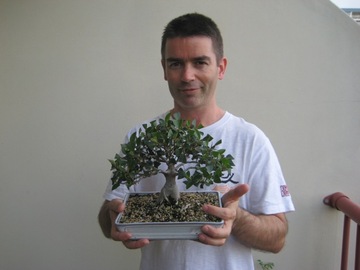
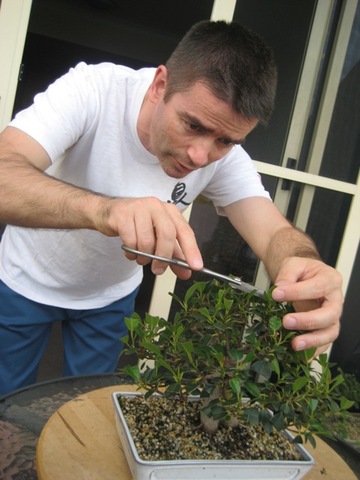
Leaf pruning guidelines:
•Early summer is ideal. Do not leaf prune after this time or the tree may not re-leaf “
•cut off 2/3 of the leaves. This helps produce 2 smaller buds at the base without removing the whole leaf. Remember, if you remove the leaf, you remove the food source.
•normally, all leaves should be removed, although foliage can be left on weaker branches that require extra strength. With the rest of the tree being bare, these remaining leaves draw the tree's energy into the branch and weak areas will quickly respond
•always remove growing tips, otherwise the shoot will continue to extend and the desired back budding may not occur
•when the tree has been leaf pruned, its demand for water will drop and so it should be watered accordingly
•once leaf pruned, position the tree in full sun for at the least the first few weeks, to encourage strong budding
•only leaf prune strong, healthy trees”
That wraps it up for this blog and I’ll be back with more exciting and knuckle-biting stuff in a few weeks. Keep all those cards ‘n letters coming in! I may even get paid by then so I can go out and buy some stamps to reply …
*Photos taken by Xavier Brusset and Jason Pover.

A couple of blogs before, we introduced you to a talented Frenchman and bonsai artist Xavier Brusset. He’s also really nice bloke and offered to help me with the technical aspect of this art and he offered advice on maintenance, watering etc. Xavier said that the shaping of bonsai, which I thought it was all about, is only one small part of it and that there’s no ‘meaning’ to creating nice bonsai if you’re not able to take care of them properly and not let them die.
He said at the basic level, important techniques are; trimming, bud cutting, repotting, pruning, fertilizing but the one most important one is the watering.

He went on to say that the frequency which we need to water, depends on the species, weather, the soil itself, size and stage of growth of the plant. The basic rule is to water when the substrate (I had to look that one up in the dictionary) is dry. In Kagawa’s summer that’s easy. He told me as it’s hot, so the best times are the mornings and evenings and to avoid midday when the sun is at it’s strongest and the plants adapt their morphology (I had to look that one up too) and that fresh water at this time could change it.

The other seasons need more careful observation by looking at the soil or the color of the leaves. So in Kagawa it’s a rule of thumb to water once a day or every other day in autumn. In winter about once a week but that we have to be careful as the wind is sometimes dry and that would require another day’s watering.
Xavier said that the other important points are the amount of water we need and to wait until the water gets out from the drain hole at the bottom of the pot. The other one is not to obstruct the drainage, so we need to be careful by using under-plates, the roots could rot if the substrate is always soaked.
Also don’t water just the soil, as the foliage also needs it. During the summer, at the end of a hot day it’s helpful to improve the effect of the dew. And also ‘wash’ the tree, to get rid of any insects and dust.
http://midoridesign3ki.blogspot.com/
So basically, that’s the way it is here in Kagawa and the northern hemisphere. Let’s now go south to Australia to see how another talented bonsai artist does things in a very different environment.
Jason Pover was a resident in Kagawa and studied bonsai his ‘hobby for life’ here with Xavier. He says now his trees are different but the passion is the same. I asked Jason for some tips and he’s offered to tell us something about pruning and I’ll let him use his own words;


“The main reasons for leaf pruning bonsai are to produce a smaller crop of new leaves, to let light reach the inner and lower branches and to gain an extra year's growth. With a second flush of new leaves, the autumn colour is also improved. Next year's buds will be activated and therefore the development of the bonsai is rapidly speeded up. Damaged or scorched leaves can be replaced with fresh new leaves; weak areas of branches can receive more light and ventilation improving the overall health of the tree. This practice is commonly done in Australia on different types of ficus to help reduce the size of the leaves and keep them in proportion with the tree. The benefits are very obvious on a mame or shohin size bonsai.


Leaf pruning guidelines:
•Early summer is ideal. Do not leaf prune after this time or the tree may not re-leaf “
•cut off 2/3 of the leaves. This helps produce 2 smaller buds at the base without removing the whole leaf. Remember, if you remove the leaf, you remove the food source.
•normally, all leaves should be removed, although foliage can be left on weaker branches that require extra strength. With the rest of the tree being bare, these remaining leaves draw the tree's energy into the branch and weak areas will quickly respond
•always remove growing tips, otherwise the shoot will continue to extend and the desired back budding may not occur
•when the tree has been leaf pruned, its demand for water will drop and so it should be watered accordingly
•once leaf pruned, position the tree in full sun for at the least the first few weeks, to encourage strong budding
•only leaf prune strong, healthy trees”
That wraps it up for this blog and I’ll be back with more exciting and knuckle-biting stuff in a few weeks. Keep all those cards ‘n letters coming in! I may even get paid by then so I can go out and buy some stamps to reply …
*Photos taken by Xavier Brusset and Jason Pover.
TAKAMATSU ART ROUNDUP 2
2011年03月28日
 What an extraordinary couple of weeks this has been for Japan. The devastation, displacement and suffering have affected everyone deeply, and of course especially those suffering in the north of the country.
What an extraordinary couple of weeks this has been for Japan. The devastation, displacement and suffering have affected everyone deeply, and of course especially those suffering in the north of the country.Hardly a time to think about ‘art’ really … still, it’s through the arts that many of us find sustenance in both good times and bad. I really don’t think this is trite and I certainly do believe it.
This month there are a couple of good shows on in town and in this blog, I’ve decided to concentrate on a combined show of two local artists both foreign residents in Takamatsu.



Adam Weston and Luca Roma will have a two-man show entitled ‘ELEMENTS’ ‘MILANO & NEW YORK’ from April 3rd~April 17th gallery times from 11:00~19:00 at the Tokiwa Art Gallery a nice little gallery I’ve written about in the past.
http://tokiwa-tag.com
Adam is from New York, Luca from Milano and both have exhibited many times both in Takamatsu and at other galleries in Japan. Adam’s long interest in the Japanese mythological ‘Kappa’ creatures has been well received by the public over these years. This time round, Adam’s painting is on view and he’s kindly given me some photos to use of ‘works-in-progress’.
Luca is a full time professional sculptor and with a large body of well received exhibitions. This time he’s continuing with his interest in linear work in the form of rope. It looks very engaging for viewers, tactile and subject to change of form. This compliments the colorist and highly textured nature of Adam’s work. It’s shaping up to be a good show and well worth a look.
Keep all those cards n’ letters rolling in and we’ll be back with more news on the art scene and other scenes going on in Kagawa in a couple of weeks.
Stay tuned … tuned? Well, you understand.
TAKAMATSU ART ROUNDUP
2011年03月15日
With the recession grinding into its 20th year these seem like gloomy times, they are of course, no doubt about it, but as with all phenomena they’ll pass. The art scene in Takamatsu is just the opposite and has a special vibrancy assisted by initiatives through businesspeople and the students from Kagawa University’s Project Team to stimulate the shopping arcades. I’ve written about this earlier as has Cathy in her previous blogs.
Around the town this month and the next there are and will be some exciting shows and stuff for us to enjoy. Let’s start off with a roundup of exhibitions in town, which your intrepid Pat’s Blogger looked at.
The Itadaki san (fish venders riding bicycles-cum-stalls) these people are Takamatsu originals pedaling slowly around the town. And from another era, the ‘Kamishibai’ (picture-card showman) are two themes and a part of the “Konkonfesta” sponsored by the Kagawa Prefecture are running through March in the Tokiwagai arcade near Kawaramachi Station. The ‘fox’ that animal with curious powers to abruptly, and at will metamorphosize in Japanese fold lore is the theme. In the Jan Garden area of Tokiwagai arcade, there will be 300 bowls of free noodles given distributed and other food stalls from 11:00~6:00 on the event day (27th March)


There are signs on the arcade walls all around Takamatsu advertizing these events in Japanese but not that hard to figure out as some of the information, event name, web links, and addresses are often in English too.
I checked Sottoprodotto http://www.sottoprodotto.com
and they’re between shows now, so nothing’s going on there until later in the month. Sorry …
The Tokiwa Art Gallery in Tokiwa Arcade has a great show running with some cute paintings by Karin Kano, a graduate of the renowned Tokyo Zokei University of Fine Arts. Karin told me she was a sculpture major and switched to painting later on.
http://calinbell.com
This show features her style in acrylics and oils. Karin has wonderful control of muted pastel colors and over-painting techniques more reminiscent of pastels than oils really.




The Takamatsu City Museum of Art has the “Exhibition Showcasing Picture Book Illustrations of the World” and it’s knockout. This runs until the 27th of March. I really enjoyed this, especially to see all original drawings and paintings of well-known books, such as the Harry the Dog Series. A childhood favorite for many kids all over the globe.
http://www.city.takamatsu.kagawa.jp/12754.html


From April 3rd there will be a show by two foreign resident-artists, Adam Weston and Luca Roma at the TAG in Tokiwa arcade entitled ‘Elements’.
“Eggore in Takamatsu” will be a one-day show on March 3rd and will be a live painting session with painter Tesshu, the didgeridoo player Takeshi Sakurai and guitarist Kenichiro Tsukiyama
http://www.eggore.com
Some pictures from last years ‘live painting event’

There are two other upcoming events that I’m unable to track down information on just yet, but I’ll both find out through my networks and will update in the next issue. They are; the A.I.R art event in Awaji-shima and Shodo-shima and also the “Art at the Temple” group exhibition in Zentsuji.
I’ll be back with more art news in a month or so and until then, keep all them cards n’ letters coming in!
Around the town this month and the next there are and will be some exciting shows and stuff for us to enjoy. Let’s start off with a roundup of exhibitions in town, which your intrepid Pat’s Blogger looked at.
The Itadaki san (fish venders riding bicycles-cum-stalls) these people are Takamatsu originals pedaling slowly around the town. And from another era, the ‘Kamishibai’ (picture-card showman) are two themes and a part of the “Konkonfesta” sponsored by the Kagawa Prefecture are running through March in the Tokiwagai arcade near Kawaramachi Station. The ‘fox’ that animal with curious powers to abruptly, and at will metamorphosize in Japanese fold lore is the theme. In the Jan Garden area of Tokiwagai arcade, there will be 300 bowls of free noodles given distributed and other food stalls from 11:00~6:00 on the event day (27th March)


There are signs on the arcade walls all around Takamatsu advertizing these events in Japanese but not that hard to figure out as some of the information, event name, web links, and addresses are often in English too.
I checked Sottoprodotto http://www.sottoprodotto.com
and they’re between shows now, so nothing’s going on there until later in the month. Sorry …
The Tokiwa Art Gallery in Tokiwa Arcade has a great show running with some cute paintings by Karin Kano, a graduate of the renowned Tokyo Zokei University of Fine Arts. Karin told me she was a sculpture major and switched to painting later on.
http://calinbell.com
This show features her style in acrylics and oils. Karin has wonderful control of muted pastel colors and over-painting techniques more reminiscent of pastels than oils really.




The Takamatsu City Museum of Art has the “Exhibition Showcasing Picture Book Illustrations of the World” and it’s knockout. This runs until the 27th of March. I really enjoyed this, especially to see all original drawings and paintings of well-known books, such as the Harry the Dog Series. A childhood favorite for many kids all over the globe.
http://www.city.takamatsu.kagawa.jp/12754.html


From April 3rd there will be a show by two foreign resident-artists, Adam Weston and Luca Roma at the TAG in Tokiwa arcade entitled ‘Elements’.
“Eggore in Takamatsu” will be a one-day show on March 3rd and will be a live painting session with painter Tesshu, the didgeridoo player Takeshi Sakurai and guitarist Kenichiro Tsukiyama
http://www.eggore.com
Some pictures from last years ‘live painting event’

There are two other upcoming events that I’m unable to track down information on just yet, but I’ll both find out through my networks and will update in the next issue. They are; the A.I.R art event in Awaji-shima and Shodo-shima and also the “Art at the Temple” group exhibition in Zentsuji.
I’ll be back with more art news in a month or so and until then, keep all them cards n’ letters coming in!
A SPLASH OF COLOR IN TAKAMATSU
2011年03月01日
Well this was an unexpected adventure. Walking down the shopping arcade wondering what to write about and the opportunity appeared right before me. The Merry Project was in town on a grey day and what a burst of vivid colors they were too. Umbrellas with smiles on them would have made even the glummest of Pat’s Blog readers happy to see.


On the dying rusted pipes that is my bicycle, I followed the group down the Marugame Machi arcade and asked for information? “We’re here to make people smile and enjoy life.” ‘ya don't say?’ I replied ‘well you’ve certainly cheered me up’ I coughed and continued. They’d become a string of color walking ever more quickly by this stage and they were filing down the arcade umbrellas up in the rainless weather, smiling and chattering.


I shot a few pictures and exchanged name cards with another of the group and promised to follow up with an article.


What wonderful colors, faces and mood-altering smiles I thought? They were off to Nao shima for the day’s activities entitled the Merry Island Project and “Smile is a Universal Language” motto. Go figure …?
http://www.merryisland.jp/


But it sure looks colorful and artistic, no doubt about it. Linking all people across borders with the universal language of smiles. Count me in! These people do the lot … conservation, planting trees, farming, you-name-it. And they’re worldwide.
http://www.merryproject.com/
I was only interested in the visual effect, which was marvelous, and as they’ll be back in town (check their news on the link in English) and I’d recommend going to see what they are and what they’re all about for the visual impact and effect is just great.
Keep all those cards, letters and emails pouring in everybody...
I’ll be back soon with some more exciting stuff as I stalk the streets and arcades on my bicycle always on the lookout for art in the old town.
Until then …


On the dying rusted pipes that is my bicycle, I followed the group down the Marugame Machi arcade and asked for information? “We’re here to make people smile and enjoy life.” ‘ya don't say?’ I replied ‘well you’ve certainly cheered me up’ I coughed and continued. They’d become a string of color walking ever more quickly by this stage and they were filing down the arcade umbrellas up in the rainless weather, smiling and chattering.


I shot a few pictures and exchanged name cards with another of the group and promised to follow up with an article.


What wonderful colors, faces and mood-altering smiles I thought? They were off to Nao shima for the day’s activities entitled the Merry Island Project and “Smile is a Universal Language” motto. Go figure …?
http://www.merryisland.jp/


But it sure looks colorful and artistic, no doubt about it. Linking all people across borders with the universal language of smiles. Count me in! These people do the lot … conservation, planting trees, farming, you-name-it. And they’re worldwide.
http://www.merryproject.com/
I was only interested in the visual effect, which was marvelous, and as they’ll be back in town (check their news on the link in English) and I’d recommend going to see what they are and what they’re all about for the visual impact and effect is just great.
Keep all those cards, letters and emails pouring in everybody...
I’ll be back soon with some more exciting stuff as I stalk the streets and arcades on my bicycle always on the lookout for art in the old town.
Until then …
The Circle of Life
2011年02月12日
I know, I know, I really did promise to be back here this week with art updates and I will but the opportunity to present a rather remarkable young man’s 88 temple pilgrimage circling around Shikoku was too much to pass up. Ryan Armstrong is a former colleague in the International Affairs Division, great sportsman, excellent dad and all-round gentleman. And … a great bloke to boot. I’ll let him tell the story replete with his magnificent photos for you and include his web address as well:
Through Henro Eyes by Ryan Armstrong
“The world is simple and pure through pilgrim (henro) eyes -- 50,000 steps; a walking stick; a daily marathon of solitary contemplation.
My walking stick (Otsue) braced me along rocky paths and stabilized slippery ground. It helped me up mountains and supported me down. The sutra on my Otsue provided mental exercise during long days and the feel of smooth wood offered familiarity during an unpredictable journey. Its every clack, 50,000 times, beat out a rhythm that moved me through another day afoot. The walking stick became my companion and partner on the Shikoku 88-Temple Circuit.

The Tools
Without time or date
Hat, stick and self
The Henro is a simple feat
I first ventured to Shikoku after hearing my college sempai say, “It’s too difficult, don’t do it.” His words, cautionary though they were, became my motivation for walking the 1200km route. Later, my objectives evolved as I sought to learn about myself and experience the traditional side of Japan.

The Marble Reflection
Along the pilgrim’s path
Did you meet the Daishi?
Yes, everyday.
I walked the pilgrimage twice, once forwards and once backwards. Both times ‘dogyo ninin’ and Shikoku’s ‘osettai no kokoro’ helped me complete my journeys.

The Mossy Wall
On the Henro
Moss and walls became my canvas.
The sun became my paint.
Always at my side
But never within reach.
In times of need
It touched my soul.
The Shadow of a Pilgrim.
'Dogyo ninin' describes the relationship between the henro and Kobo Daishi, who is embodied by the Otsue. Literally meaning, 'two people go together,' dogyo ninin and signifies how Kobo Daishi helps the henro in times of need.
For me dogyo ninin manifested itself as a growing sense of appreciation.

Happy Jizo
Can you feel the warmth of a cold stone face?
Osettai no kokoro, on the other hand, is about kindness. In the less-traditional Japanese world, osettai means wining and dining clients, but on Shikoku it means giving a gift to a henro without desire for anything in return. There are people who cannot do the pilgrimage for whatever reason -- job, health, whatever -- and this is how they participate.
One day, I was walking along a road. A man passed me in his car on his way to work and yelled “gambatte!” In the evening that same driver was going home and passed me again. Later, he drove back and gave me a bag of oranges and 1,000 yen for dinner. He said he had seen me while he was going to and from work, and he wanted to help.
I received countless gifts and constant cheers of support. I was invited to bathe and even sleep in people's homes. These kindnesses had the power to turn my day around and enable me to take one more step towards my goal.
Through Shikoku’s ‘osettai no kokoro’ I learned the effects simple acts of kindness can have on a person.

The Tent Guy
A man with no tent.
The gift of giving a gift -
Who gave us such luck?
When a pilgrim walks, temples make up one percent of the henro’s time. The rest of the time is spent traveling between temples. Thus, it's the pilgrim’s path, not the temples themselves, that makes the pilgrimage.
Still, there's one fundamental lesson I gleaned from my two distinct pilgrimages.
It all boils down to doing one’s best to live in the moment by appreciating the small things. The flower on the side of the road, the rainfall, the smile from a stranger. Good days come and go, and bad days do the same.
After a long mountainous climb I took a picture of my footprints, which were made from sweat. Through my pilgrim’s eyes, I relished that scene and thought, 'In 10 minutes they'll be gone.’

”Life is fleeting. Catch it while it's there.”
www.circle88.com
Thanks Ryan … and I’ll be back in a couple of weeks with more and of course that promised art update, which I’m working on. Keep all those cards n’ letters coming in and send me a letter if you’re interested in anything you’d like to hear about from Kagawa. I’ll answer you for sure. Until then.
Through Henro Eyes by Ryan Armstrong
“The world is simple and pure through pilgrim (henro) eyes -- 50,000 steps; a walking stick; a daily marathon of solitary contemplation.
My walking stick (Otsue) braced me along rocky paths and stabilized slippery ground. It helped me up mountains and supported me down. The sutra on my Otsue provided mental exercise during long days and the feel of smooth wood offered familiarity during an unpredictable journey. Its every clack, 50,000 times, beat out a rhythm that moved me through another day afoot. The walking stick became my companion and partner on the Shikoku 88-Temple Circuit.

The Tools
Without time or date
Hat, stick and self
The Henro is a simple feat
I first ventured to Shikoku after hearing my college sempai say, “It’s too difficult, don’t do it.” His words, cautionary though they were, became my motivation for walking the 1200km route. Later, my objectives evolved as I sought to learn about myself and experience the traditional side of Japan.

The Marble Reflection
Along the pilgrim’s path
Did you meet the Daishi?
Yes, everyday.
I walked the pilgrimage twice, once forwards and once backwards. Both times ‘dogyo ninin’ and Shikoku’s ‘osettai no kokoro’ helped me complete my journeys.

The Mossy Wall
On the Henro
Moss and walls became my canvas.
The sun became my paint.
Always at my side
But never within reach.
In times of need
It touched my soul.
The Shadow of a Pilgrim.
'Dogyo ninin' describes the relationship between the henro and Kobo Daishi, who is embodied by the Otsue. Literally meaning, 'two people go together,' dogyo ninin and signifies how Kobo Daishi helps the henro in times of need.
For me dogyo ninin manifested itself as a growing sense of appreciation.

Happy Jizo
Can you feel the warmth of a cold stone face?
Osettai no kokoro, on the other hand, is about kindness. In the less-traditional Japanese world, osettai means wining and dining clients, but on Shikoku it means giving a gift to a henro without desire for anything in return. There are people who cannot do the pilgrimage for whatever reason -- job, health, whatever -- and this is how they participate.
One day, I was walking along a road. A man passed me in his car on his way to work and yelled “gambatte!” In the evening that same driver was going home and passed me again. Later, he drove back and gave me a bag of oranges and 1,000 yen for dinner. He said he had seen me while he was going to and from work, and he wanted to help.
I received countless gifts and constant cheers of support. I was invited to bathe and even sleep in people's homes. These kindnesses had the power to turn my day around and enable me to take one more step towards my goal.
Through Shikoku’s ‘osettai no kokoro’ I learned the effects simple acts of kindness can have on a person.

The Tent Guy
A man with no tent.
The gift of giving a gift -
Who gave us such luck?
When a pilgrim walks, temples make up one percent of the henro’s time. The rest of the time is spent traveling between temples. Thus, it's the pilgrim’s path, not the temples themselves, that makes the pilgrimage.
Still, there's one fundamental lesson I gleaned from my two distinct pilgrimages.
It all boils down to doing one’s best to live in the moment by appreciating the small things. The flower on the side of the road, the rainfall, the smile from a stranger. Good days come and go, and bad days do the same.
After a long mountainous climb I took a picture of my footprints, which were made from sweat. Through my pilgrim’s eyes, I relished that scene and thought, 'In 10 minutes they'll be gone.’

”Life is fleeting. Catch it while it's there.”
www.circle88.com
Thanks Ryan … and I’ll be back in a couple of weeks with more and of course that promised art update, which I’m working on. Keep all those cards n’ letters coming in and send me a letter if you’re interested in anything you’d like to hear about from Kagawa. I’ll answer you for sure. Until then.





